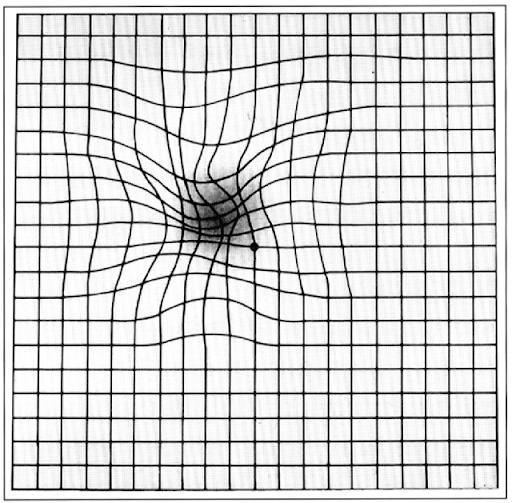How to Understand Macular Degeneration and What It Means For Your Vision
- posted: Aug. 04, 2021
Did you or someone you love recently get diagnosed with macular degeneration? It’s a lot to take in and we understand at Eye on Health. We love providing you and your family with the best service for all your vision and eye care needs here in the Phoenix area.
A big part of our commitment to individualized, special care is eye health education. Age-related Macular Degeneration (AMD) is an eye disease that affects your retina, which lines the inside of your eye like wallpaper. In the very center of the retina is your macula.
The macula is responsible for your crisp central vision, like when you read a book or look at a food label.
Just like the name says, macular degeneration occurs when the macula starts to deteriorate. As our bodies age, our eyes do too. Aging in the macula often changes vision, and we know that feels scary. That’s why we want to help you better understand this disease, so you have the tools you need to protect your vision.
Today, we’ll be talking about helpful information so you know what to look out for. The more you know, the more prepared you are to preserve your eyesight!
Why Age-Related Macular Degeneration Happens and It’s Two Different Types
We understand that any conversation about a disease that starts with the word “age” is uncomfortable. It’s not like you need a reminder of that annoying word. But this disease, in particular, centers on it, and we just can’t beat around the bush. Macular degeneration is a leading cause of vision loss for people over the age of 50.
Why?
Because as you age, your macula gets thinner and tiny clumps of protein start to form (called drusen). These drusen build up over time in your macula and cause issues with your central vision.
It’s important to know about the two very different types of age-related macular degeneration. Let’s dive in for further understanding.
AMD Type 1: Dry Macular Degeneration
The most common type of macular degeneration is the “dry” form, which nearly 80% of people diagnosed with AMD have.
What does “dry” mean in terms of AMD? A couple of important takeaways here. First, “dry” means you don’t have any leaking fluid in your macula or retina. Second, you don’t have abnormal blood vessel growth in the eye either. Both of these issues cause harm to your vision.
Most people don’t notice symptoms of dry AMD in the early stage — so it’s vital to keep your yearly eye appointments. Our optometrist can detect changes before you can! (How good does that feel?!)
The intermediate stage of AMD may cause symptoms for you but not for others. (Make sure to keep reading to learn more about the signs and symptoms.)
The late or advanced stage of dry AMD causes vision changes and loss.
AMD Type 2: Wet Macular Degeneration
“Wet” AMD means that your retina has started to grow abnormal blood vessels and is leaking fluid. (Don’t panic. Keep reading.) Around 10-15% of people diagnosed with AMD will develop the wet form. That’s right, develop.
You can have the dry form of AMD and — with time — it can turn “wet.” This form of AMD can develop quickly and requires prompt treatment. The abnormal blood vessels and leaking fluid causes damage to the macula, which negatively impacts your central vision.
When you develop the wet form of macular degeneration, it’s in addition to the dry form. Both cause damage to your vision.
Let’s discuss the important symptoms of macular degeneration.

Watch for These Symptoms of Age-Related Macular Degeneration
As we mentioned earlier, the dry form of AMD can linger unnoticed for some time. While it’s nice to not experience symptoms in your vision, these subtle changes give our optometrist important details. In your regular eye exam, Dr. Balocca gains insight into the future of your eye health and how often to monitor it for optimal results.
All forms of macular degeneration should be monitored by an eye doctor.

Common Symptoms of Macular Degeneration :
Decreased central vision
Decreased intensity of colors
A blurry or blind spot in your vision
The need for more light when reading
Difficulty adjusting to light (ex: movie theater)
Worsening central vision in one eye or both
Visual distortions (straight lines appearing bent, like on your blinds)
Any symptoms you’re experiencing in your vision are not something to take lightly. It’s easy to deny or ignore that nagging change because you’re afraid of what it might mean. At Eye on Health, we truly understand how scary vision symptoms feel. Please reach out with any vision-related questions you may have.
Schedule an appointment today if you’re experiencing any macular degeneration symptoms — or call our office at 480-809-0550!
Risk Factors for Age-Related Macular Degeneration
As the name gives it away, the biggest risk factor for AMD is age. We know that isn’t the best news, yet it’s important to understand the facts. Your risk increases 3-fold if you’re over the age of 75!
Other Important Risk Factors for AMD :
Cigarette Smoking
Genetics
Hypertension
Cardiovascular Disease
Family History
Race
Getting a diagnosis of AMD can feel overwhelming. But it doesn’t have to with a caring optometrist like Dr. Balocca. Educating and informing you on how to best preserve your vision is his mission. Read more on macular degeneration here.
Treatments for Macular Degeneration: The Good News and Bad
Currently, there is no treatment for dry macular degeneration. Depending on the severity of your eye’s health, vitamins may be an option to slow it down. A large study showed that a certain combination of vitamins can decrease the progression of the dry form of macular degeneration.
But the thing is, you may not need the vitamins yet. It really depends on the overall health of your particular eyes and the stage of your macular degeneration. Vitamins don’t prevent AMD from happening, they slow the progression.
Having a detailed eye exam, with our Phoenix optometrist is all it takes to know the level of your macular degeneration and if eye vitamins are right for you.
There are treatments for the wet form of macular degeneration. We’re going to give it to you straight — most of the time it involves injections into your eye.
We know, we know. It sounds terrible. But remember, only 10-15% of people end up with wet macular degeneration.
Dr. Balocca doesn’t perform injections at Eye on Health. But he’ll get you to an ophthalmologist (a medical doctor specializing in eye care) if you have wet AMD.
We hope your vision never deteriorates to the point of needing those treatments, but they may significantly improve your vision. And with the latest technology and good doctor — your vision is worth it.
Get Routine Eye Exams at Eye on Health to Check For AMD
Dr. Balocca became an optometrist in the Phoenix area to help you and your family with your vision and eye care concerns. If you’re lucky enough to live in Youngtown or Sun City, he’ll gladly be your eye doctor.
It’s valuable to understand macular degeneration and the harm it can cause to your vision. Your yearly eye appointments help the optometrist help you keep your vision!
Monitoring your vision with an Amsler grid can help, and you can learn more here. When you come to our office, we’ll give you one and make sure you know how to use it.
Dr. Balocca Cares About Your Vision Needs and Concerns.

Call Our Office at 480-809-0550 or Schedule an Appointment Today!
Sources:
Our Location
Estrella Medical Plaza
9305 W. Thomas Rd. Ste. 455
Phoenix, AZ 85037
